公東高工是瑞士白冷會(Bethlehem Mission)在1953年來到臺灣宣教後在臺東所籌建的技職學校。當建築師達興登(Justus Dahinden, 1925-)接受委託設計此學校建築時,他委請了瑞士藝術家艾伯特‧威德爾(Albert Wider, 1910-1985)在1960年為學校聖堂設計其內的教堂藝術,如彩繪玻璃、苦像,聖體櫃,與祭桌等。本文以此聖堂內的「苦路(stations of the cross)十四景」系列彩繪玻璃為探討對象,釐清它們的技術特質、風格特色、圖像創新,以及所反映出的歐洲現代教堂藝術發展趨勢,及瑞士海外宣教運動。上述議題的探討顯明,威德爾的苦路系列彩窗遵循了瑞士德語區的教堂彩繪玻璃趨勢,以色玻璃與鉛條鑲嵌技術為主,突顯材質特色。溫和的抽象性人物造形與幾何線條設計除了流露出表現主義與新客觀主義風格的影響,還保留了在1950年代被視為教堂藝術中不可或缺的易讀性。這些彩繪玻璃無論在風格或內容上,都與空間內的苦像、祭桌,與教堂建築相輔相成,形塑一個有助於深化信仰經驗及禮儀專注之整體藝術氛圍。這樣的設計不但彰顯出
藝術家個人對教堂藝術暗示性功能的堅持,也流露出當代歐洲禮儀改革運動的訴求。別具意義的是,公東高工是瑞士「宣教建築師協會」(Bund der Missionsarchitekten/BMA)支援海外宣教的實例,為瑞士藝術界與宣教工作的互動、並嘗試在異國樹立具典範性基督教藝術的努力留下珍貴紀錄。
This study investigates the 14 stations of the cross in stained glass in the Kung-Tung chapel, examining the material characteristics, unique style, iconographic invention, and how the work is reflective of European church art development and the overseas mission movement in Switzerland. The background of the Kung-Tung chapel can be traced to the Kung-Tung Technical Senior High School founded by the Swiss Bethlehem Mission, present in Taiwan since 1953. When the architect, Justus Dahinden (1925-), was entrusted with the task of designing the school and its chapel, he invited the artist Albert Wider (1910-1985) to create the whole set of church art, including the stained glass, crucifix, altar, tabernacle, etc. Following contemporary trends in modern religious stained glass in the German-speaking part of Switzerland, Wider used traditional techniques to shape the colored glass mounted in strips of lead to reinforce the aesthetic impact of the material. While the subtle abstraction and geometrical designs of the images reveals the influence of Expressionism and New Objectivity, this modern stained glass work sustains the legibility of the motifs: an indispensable function of church art during the 1950s. The style and content of Wider's stained glass complement the crucifix, altar, and the rest of the church architecture, with the entire set of the windows playing an important role in forming a Gesamtkusntwerk (a synthesis of the arts) which enhances the impact of the liturgy and deepens the religious experience for visitors. The design of the stained glass reflects the artist's belief in the role of church art in conveying clear messages, and the aims of the European liturgical movement. It is particularly noteworthy that the school with its chapel were realized by the “Bund der Missionsarchitekten” (Society of Architects for the Mission), and bear witness to the collaboration between Swiss artists with the overseas mission, and their efforts to establish inspiring models of Christian art in non-Christian countries.


